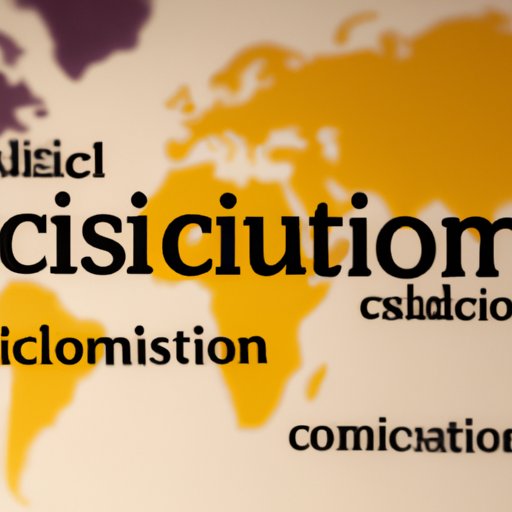Introduction
Cultural diffusion is a term used to describe the spread of cultures, beliefs, and ideas from one place to another. It is a process that has been occurring since ancient times and continues to shape our world today. In this article, we will explore what cultural diffusion is, its history, and its impact on global identities. We will also analyze some examples of cultural diffusion and discuss the positive and negative effects it has on society.
A Historical Overview of Cultural Diffusion
To understand the definition of cultural diffusion, we must first define the terms “culture” and “diffusion.” Culture refers to the set of shared values, beliefs, and practices that a particular group of people have. Diffusion is the process of spreading something from one place to another. So, when we talk about cultural diffusion, we are referring to the spread of a culture or culture-related ideas from one place to another.
Cultural diffusion has been happening since ancient times. For example, during the Roman Empire, Latin was spread throughout Europe, while Buddhism was spread throughout Asia. Today, we can see evidence of cultural diffusion in the form of different languages, religions, and customs that exist in different parts of the world.

Exploring the Causes and Effects of Cultural Diffusion
There are many factors that contribute to cultural diffusion. One of the most common is migration, which occurs when people move from one place to another. This could be for economic reasons, such as seeking better job opportunities, or for political reasons, such as escaping from conflict or persecution. Migration often leads to the spread of culture, as people bring their traditions, language, and beliefs with them to their new home.
Another factor is globalization, which is the increasing interconnectedness of the world due to advances in technology and transportation. This has made communication and travel easier, allowing people to learn about and interact with cultures from other parts of the world. Trade is also a major contributor to cultural diffusion, as goods and services are exchanged between different regions, allowing for the exchange of ideas and customs.
The effects of cultural diffusion can be both positive and negative. On the positive side, it can lead to greater understanding and appreciation of different cultures. It can also create opportunities for economic growth, as different cultures offer unique products and services that can be traded. On the negative side, it can lead to cultural homogenization, where one culture becomes dominant and threatens the existence of other cultures.
Analyzing Examples of Cultural Diffusion
Cultural diffusion can take many forms, depending on the region. For example, in the Americas, Spanish and Portuguese are two languages that have spread due to colonization and immigration. In East Asia, Buddhism has been a major influence, while in the Middle East, Islam has had a significant impact.
Technology has also played an important role in cultural diffusion. The internet has allowed people to access information from all over the world, allowing them to learn about different cultures and connect with people from different backgrounds. Social media platforms like Facebook and Twitter have also enabled people to share and discuss ideas with others from around the globe.

Examining How Cultural Diffusion Shapes Global Identities
Cultural diffusion has a major impact on global identities. It affects language, as different languages mix and evolve over time. It also affects religion, as different faiths are adopted by different cultures. And it affects social values, as different cultures have different ideas about what is considered acceptable behavior.
These changes can lead to tensions between different cultures, as some may feel threatened by the spread of foreign ideas and beliefs. But they can also lead to greater understanding and acceptance, as people become more familiar with different cultures and find common ground.

Exploring the Impact of Cultural Diffusion on Society
Cultural diffusion can have both positive and negative impacts on society. On the positive side, it can lead to increased understanding and respect between different cultures, as well as economic growth through the sharing of products and services. On the negative side, it can lead to the loss of local cultures and the domination of one culture over another.
It is important to recognize that cultural diffusion is a complex process that cannot be easily controlled. While it can have both positive and negative impacts, it is ultimately up to individuals and communities to decide how to respond to it in order to ensure that their own culture is respected and preserved.
Conclusion
In conclusion, cultural diffusion is an important process that shapes global identities. It is a complex process that has been occurring since ancient times and has a variety of causes and effects. It can have both positive and negative impacts on society, and it is important to be aware of these so that we can respond appropriately. Understanding cultural diffusion and its implications is essential for creating a more tolerant and accepting world.
(Note: Is this article not meeting your expectations? Do you have knowledge or insights to share? Unlock new opportunities and expand your reach by joining our authors team. Click Registration to join us and share your expertise with our readers.)
